Calcium sulfonate complex greases
Debbie Sniderman, Contributing Editor | TLT Webinars October 2016
Chemtura technology manager Wayne Mackwood examines grease’s chemical composition, classifications, test procedures and additive packages.

© Can Stock Photo Inc. / ruhmal
KEY CONCEPTS
•
Tribology’s unsung hero—grease—has many advantages over oil-based lubricants.
•
Greases are made of three components: thickeners, oils and additives.
•
The most important grease test is the ASTM D217 Grease Consistency Test, which ensures the grease has a consistent starting point.
MEET THE PRESENTER
This article is based on a Webinar originally presented by STLE University on August 5, 2015. “Calcium Sulfonate Complex Greases” is available at
www.stle.org: $39 to STLE members, $59 for all others.
Wayne Mackwood is the technology manager for detergents and greases for Chemtura Corp. and is based in Toronto. He is an expert in the design, manufacture and use of calcium sulfonate complex grease. For more than two decades he has developed over 150 grease formulations for the mining, steel production, paper and pulp, power generation, transportation, food-processing and marine industries.
Most of his career Mackwood has served as a scientist with marketing and asset-management roles. He is a member of STLE, NLGI and EGLI. He has previously served on STLE’s board of directors and is currently a board member with NLGI. Mackwood has a bachelor’s of engineering and a master’s of engineering in materials science with a focus on tribology from the University of Western Ontario.
You can reach Mackwood at
wayne.mackwood@chemtura.com.
 Wayne Mackwood
Wayne Mackwood
MOST PEOPLE KNOW WHAT GREASES ARE and how they are used as a lubricant. There are some disadvantages to grease when compared to oil products, the biggest being reduced pumpability. They’re also harder to replenish compared to oil lubricant systems, offer poorer cooling abilities, increase frictional drag and are harder to clean
in-situ. They don’t offer the ability to boost their properties when used with additives, therefore making grease replenishment a necessity. Their low-temperature performance might not be as good as oils, and their thickeners oxidize and degrade. They also are not as generally recyclable as oils.
However, greases do offer many advantages over oils. They have a superior ability to seal out contaminants, and they drip and mist less. They are the best choice when solid additives like graphite are needed, and they’re very useful when operating in extreme conditions like high pressures and temperatures, water contamination or shock loading. They also are very important where there is intermittent operation.
CLASSIFYING GREASES
Greases can be classified and referred to in many ways, but the main way is by consistency or stiffness as specified by the National Lubricating Grease Institute (NLGI) grade. Greases also can be referred to by thickener type such as lithium or calcium grease. They can be classified by base oil types such as synthetic or mineral, or by base oil viscosity specified by the International Standards Organization Viscosity Grade, such as ISO 60 or ISO 100 grease.
Some classify grease by its ability to carry loads, whether it’s an EP or non-EP grease or by its application such as food-grade grease, wheel bearing grease or steel mill grease. Others classify grease by color, which is the most unreliable method since in any given facility there might be several greases sharing the same color.
THICKENERS
Greases are made of three components: thickeners, oils and additives. Thickeners are ways to gel the grease and typically range from 3%-35% of a grease by volume. Oils in greases are the key components that allow them to act as lubricating fluids and typically compose 65%-95%. Additives impart or enhance specific performance aspects to the lubrication and can range from 1%-15% of grease’s volume.
Many ways to thicken a fluid into a grease have been developed over the years: simple soaps, complex soaps and non-soap thickeners. Simple soaps are organic materials based around standard metals that when reacted form metal salts. They typically have dropping points under 210 C. Lithium, calcium, sodium and aluminum are typical metals used in simple soap thickeners.
Complex soap thickeners look like simple soaps, but they have been further complexed and contain other additives that react to create more robust structures offering different properties. The standard types of complex soap thickeners are lithium complex, aluminum complex, calcium complex and calcium sulfonate complex, and their drop points are typically above 210 C.
Non-soap thickeners can be reacted products or dispersion-type gels whose high-speed dispersion causes fluids to thicken. They typically have high dropping points well above 210 C. Popular non-soap thickeners include polyurea, bentonite clay, silica, graphite, PTFE and polymers.
Based on the latest data from the NGLI’s global 2014 Annual Grease Production Survey, lithium products still compose a large portion of the grease market. There have been changes in the different types of soaps used as thickeners, but overall grease production has remained the same or declined slightly from 2010-2014. However, the biggest change in that time has been with calcium sulfonate complexes (CSC), whose production has almost doubled and where interest has grown in all regions of the world.
OILS AND ADDITIVES
Grease is mainly made up of base oils, which can be any type from Groups I-V. Most are made from Group I and II, but there are many made with synthetic oils from Groups III, IV and V. A high percentage of synthetic greases use PAO as its base oil, and some PAG-based oil-soluble greases are starting to be seen. Natural and synthetic esters, silicones, fluorocarbons and phosphate esters also are used. Alkylated naphthalene base oils are becoming popular in greases used for some specialty applications.
Additives are the final components of grease, and all of the same types that can be found in lubricating oils can be found in greases. Dyes and pigments are popular for coloring grease, as well as tackifiers, antioxidants, anticorrosion agents, rust inhibitors, metal deactivators and EP or antiwear agents. Polymers and other water-resistant additives also are used, along with VI improvers. Pour point depressants are being investigated as to how they may affect grease, but it is hard to say how effective they are at changing its properties.
CSC GREASE TECHNOLOGY
The first calcium sulfonate greases were formed by intentional investigation. Thickening sulfonates were found to help change flow from Newtonian to non-Newtonian. The first products were mainly used as thickened coatings and as rheological and corrosion inhibitor additives for paints and other coatings. However, some did find use as lubricating grease.
Although thickened sulfonates formed the basis of ‘simple’ greases, this technology wasn’t widely adopted until the early 1980s when high-performance complex versions were developed by Muir et al. at Witco (now Chemtura). Several modifications followed in the 1990s. Since then, NCH, Lubrizol, BP Castrol and Royal Manufacturing, among others, have studied the technology, made improvements, issued patents and taken the technology in different directions.
CSC greases commonly exhibit high dropping points, excellent water resistance and mechanical stability. They also have excellent corrosion protection properties, low wear and high EP, all of which are specific to CSC grease. Due to their excellent properties and increased industrial use, they are generating a lot of interest, and many are currently studying and presenting research papers about them at industry conferences.
CSC GREASE STRUCTURE
Calcium sulfonate detergents, like many additives in the lubrication industry, are composed of two parts, a hydrophilic head and a lypophilic tail (
see Figure 1). The head provides the additive’s properties, and the tail keeps it in the oil.
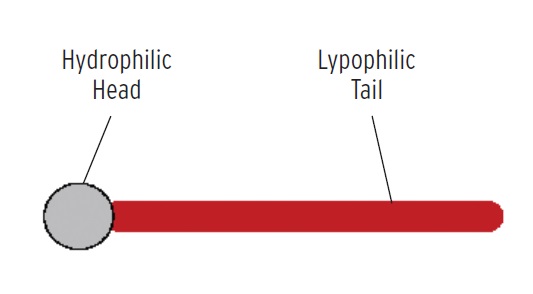 Figure 1. Sulfonate head and tail chemistry. (Figure courtesy of Chemtura Corp.)
Figure 1. Sulfonate head and tail chemistry. (Figure courtesy of Chemtura Corp.)
The hydrophilic head is a neutral salt of a strong acid and could be from many different metal types. The metal in CSC grease is calcium. Forming the head involves several chemical reactions that start with paraffinic olefins and aromatics. A sulfonate results from the process of sulfonation using SO3, which changes to a strong sulfonic acid. Depending on the starting source of the aromatic and the lypophilic tail associated with it as well as the base and process, different sulfonate micelle structures are formed.
The tail is an alkane whose length can lie in the range of C10-30. Its shape could be linear, single branched or many branched, and it can have multiple substitutions on its ring, each giving different properties. Tails are formed from alkylates that either are made intentionally from benzene, or toluene, or come from other processes such as the sulfonation of Group I oils, or from the LAB manufacturing process.
COMPLEX AND SIMPLE CALCIUM SULFONATE GREASE MANUFACTURING
The neutral calcium sulfonate process involves mineral oil, solvent, sulfonic acid, water and calcium hydroxide. It produces very small micelle particles that are 0.5-10 nm in diameter and essentially neutral once they have been removed from the solvent.
Further processing of that neutral with carbonation, promoters and more solvents grow micelles to be a little larger inside, about 10-30 nm, where amorphous calcium carbonate forms.
The calcium sulfonate micelle is then converted to crystalline form by treating with heat and polar solvents (
see Figure 2). Sulfonic acid detergent is used as a common reactant to help vary the molecular weight of the material and allow the proper crystal form. Calcium sulfonate crystals swell to the size of 100-400 nm and take the desired form of calcite crystals. Calcite’s layered wafer-like structure has shear planes, which offers improved lubricity and other properties compared to aragonite with needle-like structures or others with amorphous structures that don’t have shear planes.
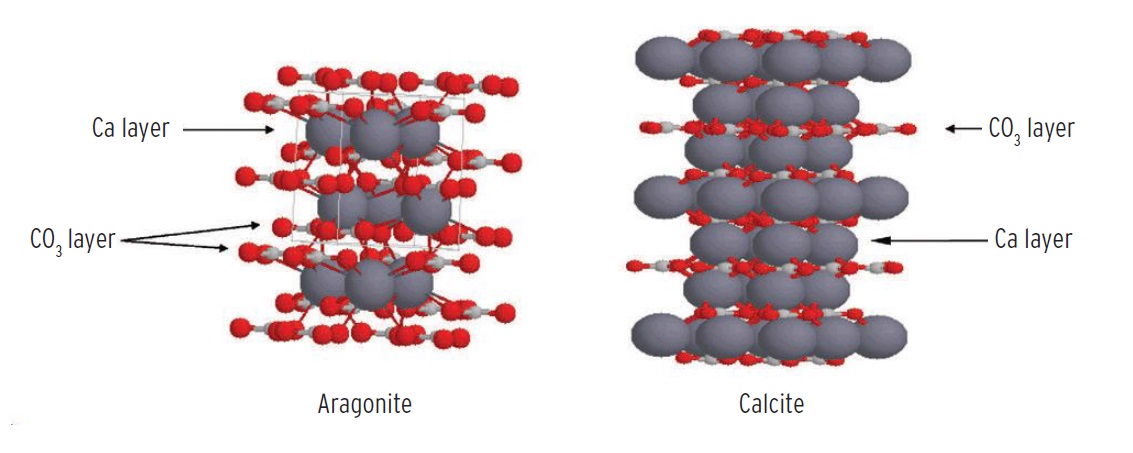 Figure 2. CSC crystalline structure. (Figure courtesy of Chemtura Corp.)
Figure 2. CSC crystalline structure. (Figure courtesy of Chemtura Corp.)
Further processing with oil, water, alcohol, acetic acid, heat and the proper mixing and cooling times allow thickening to occur and the simple grease to form (
see Figure 3). After driving off all the water and adding trim oil and any additives, milling and homogenization, the grease may undergo filtering and deaeration until it’s the right consistency before packaging.
 Figure 3. Simple CS grease (left) and simple Grade 2 CS grease (right) have a more translucent appearance. (Figure courtesy of Chemtura Corp.)
Figure 3. Simple CS grease (left) and simple Grade 2 CS grease (right) have a more translucent appearance. (Figure courtesy of Chemtura Corp.)
In simple CS greases, a very high content of thickeners are used, around 40%-50% in Grade 2 depending on the base oil used. Thickener includes Ca sulfonate, without the oil present in the base, calcium carbonate and calcium acetate, if present.
In complexed versions of the grease, the manufacturing process includes a key component that allows significantly less thickeners to be used in the product. The key complexing or co-thickening agent that almost all manufacturers include is 12-Hydroxysteric acid (12HSA). This allows thickener content in Grade 2 grease, depending on the processes used, to be reduced to as low as 15%-35%, with 30% being the most common amount used.
The thickener in a CSC grease can include Ca sulfonate (without oil), calcium carbonate, Ca borate, Ca phosphate and Ca acetate (if present). Ca borate, Ca phosphate and Ca acetate are not necessarily required, but the final properties of the grease may differ with varying compositions. Some CSC greases are made without them. The 12HSA can be added at different stages, with final properties dependent on when it is added. When borate and phosphate are used, they become part of the complex, improving high temperature rheology and imparting better wear.
Complex CSC grease looks more opaque than simple Ca sulfonate grease, which looks more transparent (
see Figure 4). The presence of calcium borate or calcium phosphate in the complex grease increases its opacity.
 Figure 4. Complex CS grease has an opaque appearance. (Figure courtesy of Chemtura Corp.)
Figure 4. Complex CS grease has an opaque appearance. (Figure courtesy of Chemtura Corp.)
CSC COMPATIBILITY
Table 1 summarizes CSC compatibility data compiled from industry literature and work performed at Chemtura Corp. on calcium sulfate complexes over the years. In general, CSC greases are fully compatible with anhydrous calcium and lithium complex products. Substances highlighted in red are generally not compatible.
Table 1. CSC grease compatibility chart
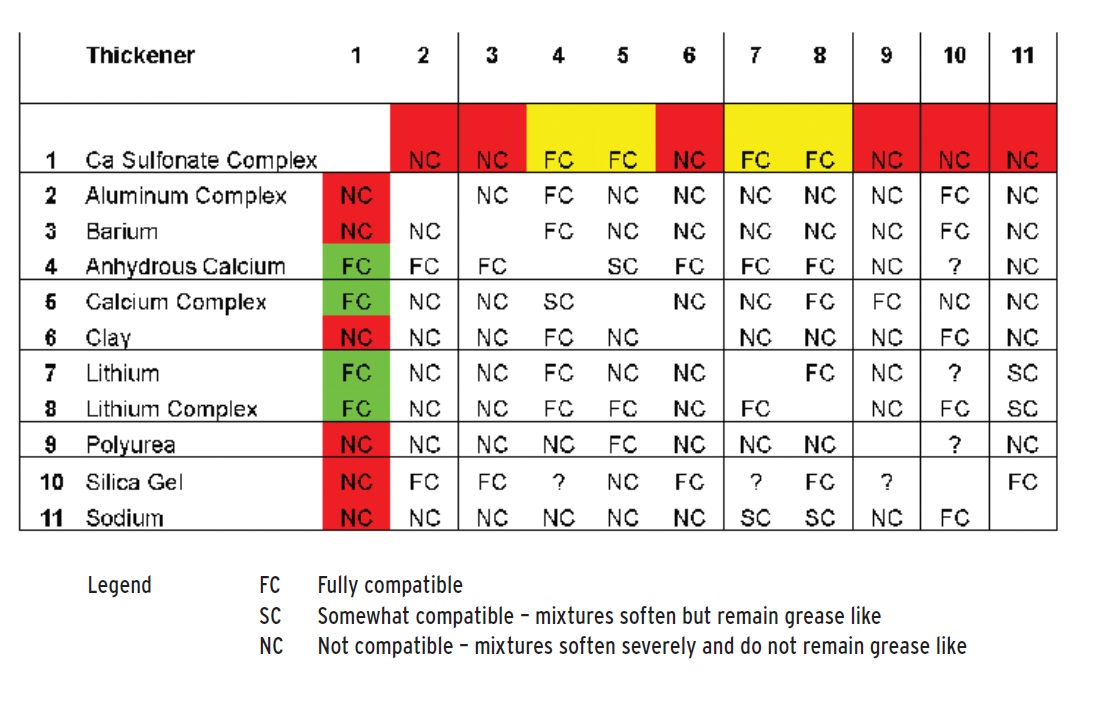 Table courtesy of Chemtura Corp.
Table courtesy of Chemtura Corp.
When mixing incompatible substances together in a bearing, mechanical stability test or another application, under certain conditions one or both of the thickener structures typically will collapse, making the mixture lose consistency. Also, the dropping point may reduce considerably below the original point of each substance.
Compatibility between two greases depends on a number of factors: relative concentration, the degree and duration of mixing, temperature and types and extent of external contamination. Rules of thumb like these can be used to determine compatibility. But if used in an application is critical, as most are, it is best to have the compatibility tested.
HOW GREASES ARE TESTED
Grease is one of the most tested products and has the most tests written for it. The ASTM specifies many tests, and there are others developed by bearing companies and industries where grease has found its way into the work. Some tests are quite old and are still used, and others may not be relevant.
The most important test for grease is the ASTM D217 Grease Consistency Test that ensures the grease has a consistent starting point (
see Figure 5). A weighted cone is dropped into level grease and the depth of penetration is measured: the greater the depth, the softer the grease. The penetration is measured after 60, 10,000 and 100,000 double strokes. A change in consistency gives an indication of application stability. Performance also can be compared when water is added as well.
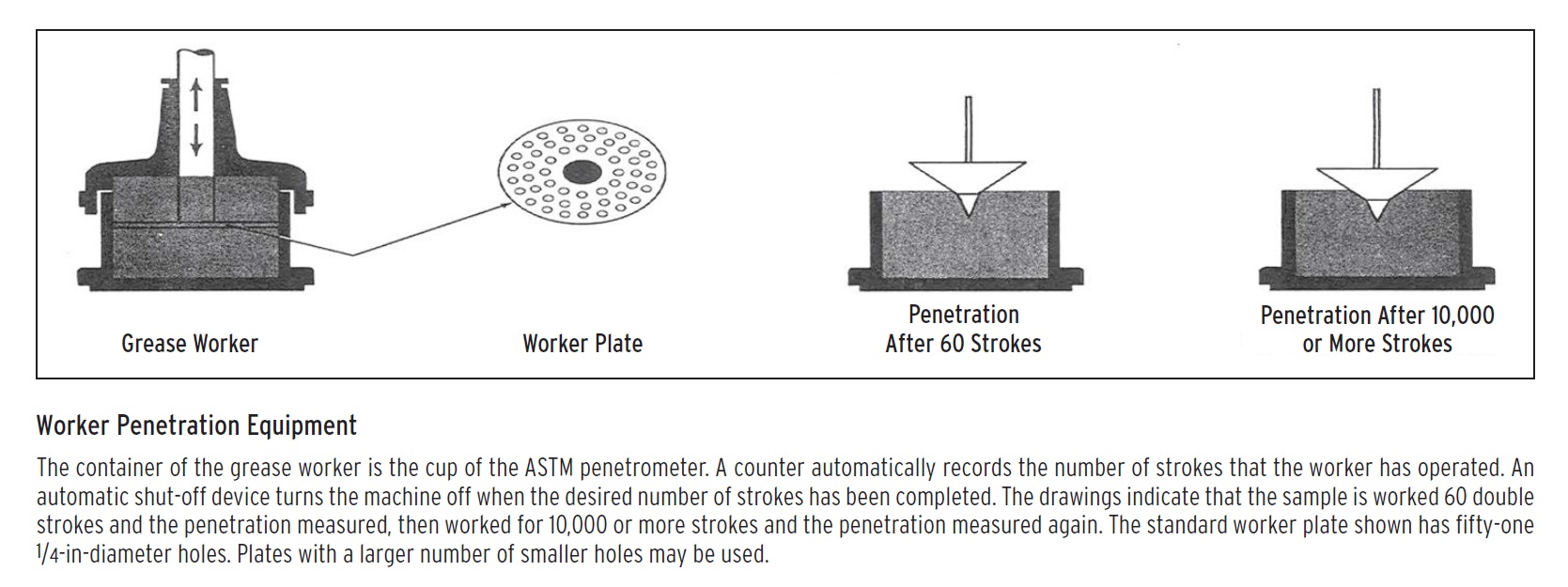 Figure 5. Setup for testing the consistency of grease with the Grease Penetration Test. (Figure courtesy of Chemtura Corp.)
NLGI CONSISTENCY CLASSIFICATION
Figure 5. Setup for testing the consistency of grease with the Grease Penetration Test. (Figure courtesy of Chemtura Corp.)
NLGI CONSISTENCY CLASSIFICATION
Greases are assigned a grade in units of 30 points, with a 15-point gap between each grade to ensure no overlap. Many suppliers quote half grades such as 0.5 or 1.5 indicating the grease is between grades, but they are not official. Grade 000 is the softest. Grade 2 is the most common. Grade 3 has a consistency similar to peanut butter (
see Figure 6).
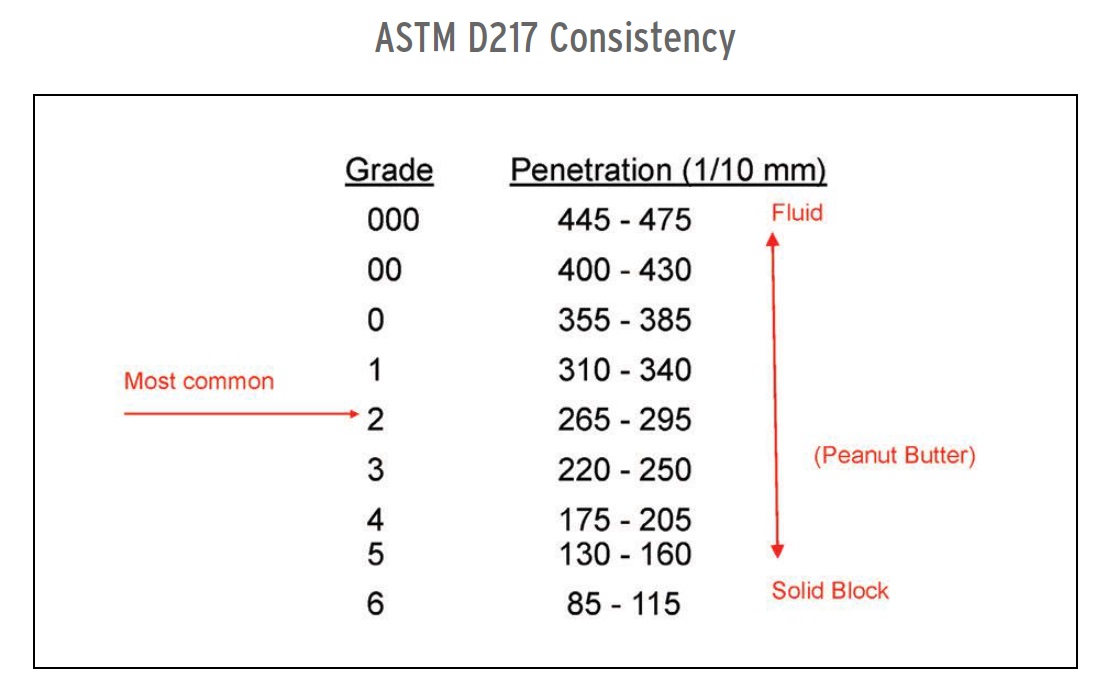 Figure 6. The NGLI grease classification system. (Figure courtesy of Chemtura Corp.)
Figure 6. The NGLI grease classification system. (Figure courtesy of Chemtura Corp.)
The next most important test is the Dropping Point Test, specified by ASTM D2265 (
see Figure 7). This tests the temperature at which the thickener matrix can no longer hold oil, which is the point when the grease can no longer serve its purpose. The dropping point temperature is not the melting point of the grease. The higher the dropping point temperature, the better. A thin smear of a small sample the size of a thimble is watched to see when droppable oil falls from a cup as the temperature is increased. According to the ASTM method, grease is tested up to a maximum of 316 C (600 F).
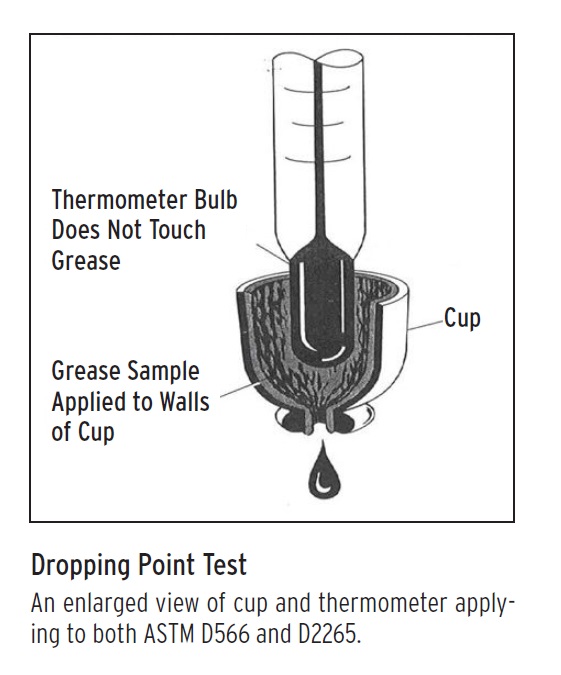 Figure 7. Test setup for testing the dropping point of grease. (Figure courtesy of Chemtura Corp.)
Figure 7. Test setup for testing the dropping point of grease. (Figure courtesy of Chemtura Corp.)
Greases also are tested for wear and load performance with the 4-Ball Wear Test and the 4-Ball EP Test. The wear test identifies wear and boundary wear regimes. One ball is rotated under load against three stationary balls held tight in a metal cup filled with the test grease. The test is run at 40 kg, 1200 rpm and 75 C for 60 minutes. The diameters of the circular scars formed on the three lower balls are measured in millimeters and averaged. The smaller the diameter the better protection afforded.
The 4-Ball EP Test pushes and goes beyond the wear regime. One ball is again rotated under load against three stationary balls held tight in a metal cup filled with the test grease. Run at 1770 rpm, 25 C for 10 seconds, this test starts at 80 kg and adds successive loads to 800 kg or until welding occurs. The weld point is reported. The Load Wear Index is a measure of the wear associated during the testing. The higher the number the better the lubricant can protect against wear at high loads.
The two tests are very commonly referenced on grease specifications and datasheets. There continues to be much debate in the grease and testing world about how relevant either test is in real world conditions. Better methods may exist. But until new tests are widely adopted, these two and other tests will continue to be used to characterize grease performance.
There are two other important grease-specific tests: water washout and spray tests. In the ASTM D1264 Water Washout Test, grease is weighed before and after one hour of testing to see how much of it has been removed from a shielded packed bearing with a water spray impinging on it (
see Figure 8). A motor spins a bearing and pumps water running at 600 rpm, with a 5 cm3/s flow rate and either 79 C or 38 C water. The bearing is dried in an oven, and the weight loss after one hour is determined.
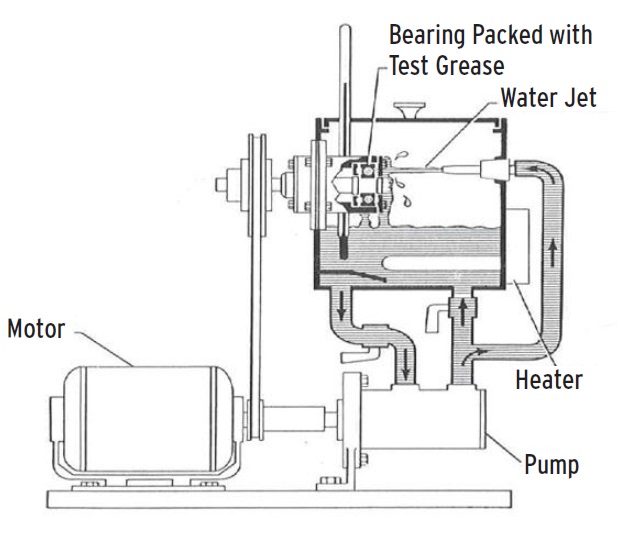 Figure 8. Setup for the Water Washout Test. (Figure courtesy of Chemtura Corp.)
Figure 8. Setup for the Water Washout Test. (Figure courtesy of Chemtura Corp.)
In the ASTM D4049 Water Spray Resistance Test, a weighed amount of grease is coated on a horizontal metal panel and is exposed directly to water spray from above for five minutes (
see Figure 9). The panel is dried in an oven and the weight loss is used to determine the percent sprayed off. The less removed the better. While these two tests are similar, they measure something different depending on the amount of water the grease is exposed to. In large bearings where more water flows through than in a small bearing, results from this test may be more relevant (
see Additional Grease Tests).
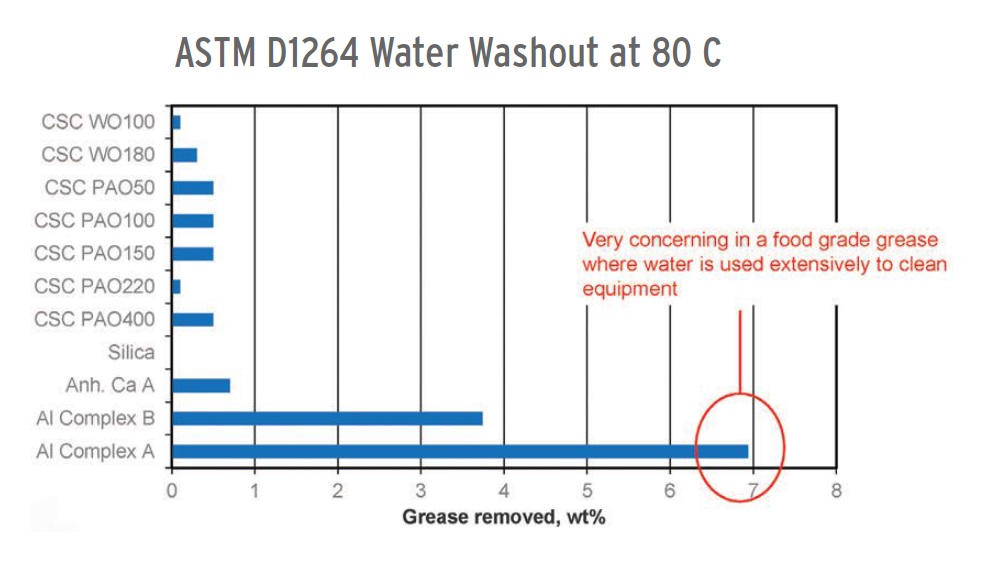 Figure 9. Comparing water resistance properties food-grade CSC and non-CSC greases with the Water Washout Test. (Figure courtesy of Chemtura Corp.)
Figure 9. Comparing water resistance properties food-grade CSC and non-CSC greases with the Water Washout Test. (Figure courtesy of Chemtura Corp.)
ADDITIONAL GREASE TESTS
•
Oxidation
o
ASTM D5483-02 Pressure Differential Scanning Calorimetry
o
ASTM D3527 Wheel Bearing Life Test
o
ASTM D3336 High Speed Bearing Life Test
o
FAG FE9 Test
o
Oven Panel Test
o
ASTM D942 Bomb Oxidation
•
Mechanical stability
o
ASTM D1831 Roll Stability
•
Bleed/leakage
o
ASTM D6184 Cone Method Oil Bleed
o
ASTM D1742 Oil Bleed
o
ASTM D4290, D1263 Wheel Bearing Leakage
•
Mobility/torque
o
ASTM D4693 and D1478 Low Temperature Torque
o
ASTM D1092 Apparent Viscosity
o
US Steel Mobility
o
Lincoln Ventmeter
•
Corrosion
o
ASTM D4048 Cu Corrosion
o
ASTM D1743 Bearing Corrosion
o
ASTM D6138 Emcor Corrosion.
INDUSTRIAL EXAMPLES OF CSC GREASE PROPERTIES—AUTOMOTIVE BEARINGS
One of the first industries to use CSC grease was pulp and paper, and its primary use continues to be there. Three other industrial examples, automotive wheel bearing, industrial steel mills and food processing, highlight typical properties and performance that CSC greases bring.
CSC greases used in automotive wheel bearings must meet many industry requirements such as the NLGI GC/LB Specification and ASTM D4950. These tests are similar to the SAE J310, which has not been updated in several years. GC is most relevant now, with its higher standards than GA and GB. In chassis lubrication, LB is becoming the more important standard since most chasses aren’t available to be lubricated aftermarket. In addition, other internal manufacturer specs may be present.
An NLGI working group is currently investigating the relevancy of the NLGI GC/LB test protocol. Using aftermarket grease in wheel bearings and chassis points has significantly diminished. So far, the group has found that the spec is good for describing moderate- to high-performance grease. It is probably referenced for that reason more than for wheel bearing use.
Chemtura performed industry tests on two types of CSC products: ISO 150 with a mineral oil base and PAO50 with a synthetic base. All CSC greases compatible with mineral oils met the specs easily. They showed good oil separation and low spray out. In the 4-Ball EP ASTM D2596 Test, both test results were good.
In the Bearing Life Test at low temperatures, the mineral oil passed the 80-hour minimum lifetime and lasted 100 hours, and the synthetic PAO showed a lifetime improvement to well over 200 hours (
see Figure 10). This is typical for the synthetic technology.
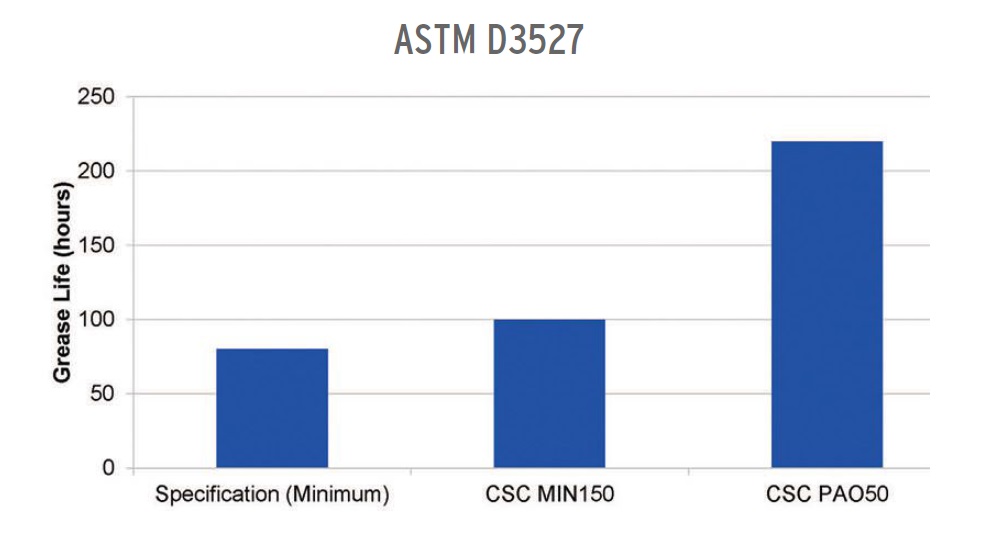 Figure 10. Two CSC greases offer superior performance in the Automotive Bearing Life Test. (Figure courtesy of Chemtura Corp.)
Figure 10. Two CSC greases offer superior performance in the Automotive Bearing Life Test. (Figure courtesy of Chemtura Corp.)
The Low-Temperature Torque Test (tapered roller bearing) (ASTM D4693) showed similar results at the cold temperature of -40 C (
see Figure 11). The mineral oil-based grease met the spec, but there was a noticeable improvement in torque with the lower viscosity synthetic PAO-based grease. These findings are important to automobile users in the north that experience cold winter nights and want to be sure components are not damaged when first starting in the morning.
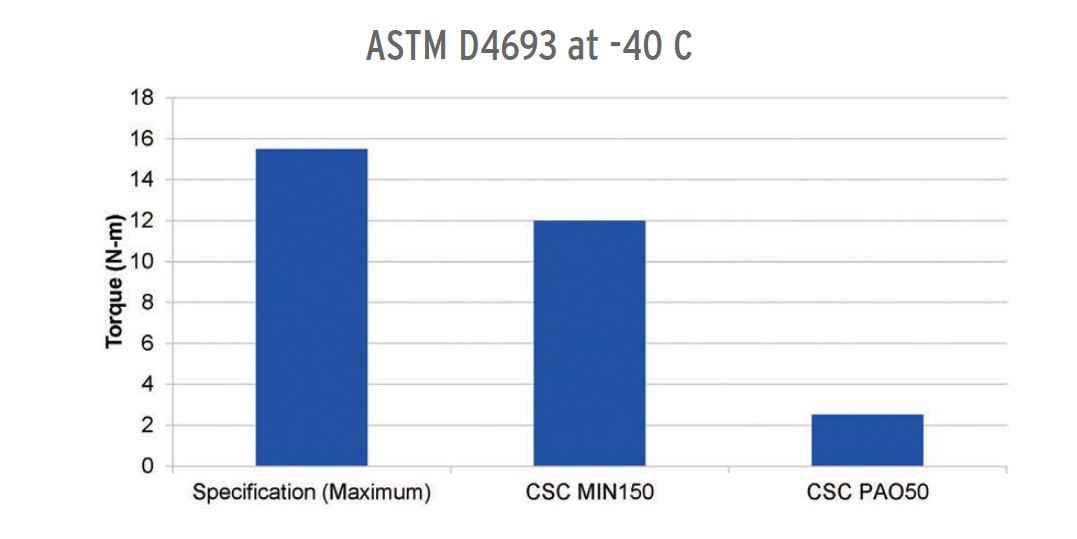 Figure 11. Two CSC greases offer superior performance in the Automotive Low Temperature Torque Test. (Figure courtesy of Chemtura Corp.)
Figure 11. Two CSC greases offer superior performance in the Automotive Low Temperature Torque Test. (Figure courtesy of Chemtura Corp.)
Fretting wear is important in bearings that have been packed in grease while the automobile is transported by train or truck. Most fretting wear will occur when there are high frequency vibrations but no rolling motion, like during transport. The CSC greases performed well on fretting wear tests.
FOOD PROCESSING INDUSTRY EXAMPLE
There is a lot of data available about CSC grease performance in machinery used in the food processing industry. CSC grease obtained NSF H1 status in 2001 and finds use in mixing, crushing, canning, bottling and package manufacturing applications. Chemtura tested several PAO-based and white oil-based CSC formulations and compared the results to Grade 1.5-2 aluminum complex greases, anhydrous calcium greases (which are not high temperature greases) and silica.
The performance of CSC grease in the areas of load, water, shear and temperature offered much-improved performance over the other technologies. At the time of the testing, most of the other greases were limited by their choice of performance additives. That landscape is changing now as more additive chemistries are gaining approval under the HX-1 program.
The CSC greases all performed very well in the water-resistance test, which is important in food industry equipment that undergoes the worst case scenario where water is used extensively to clean the equipment. Compared to aluminum complexes, much less of the CSC greases was removed, all less than 1%.
CSC grease also showed excellent antiwear properties in the ASTM D2266 4-Ball Wear Test, where silica indicated insufficient performance (
see Figure 12). In the ASTM D2596 4-Ball EP Test, CSC grease showed excellent load carrying properties (
see Figures 13 and 14). Also, all of the sulfonates tested in the ASTM B117 Salt Fog Test showed excellent corrosion resistance, when very thin 1-mil thick coatings ran more than 1,000 hours (
see Figure 15). Competitors were nowhere near as good and failed in less than 150 hours, typical of most food-grade industrial greases.
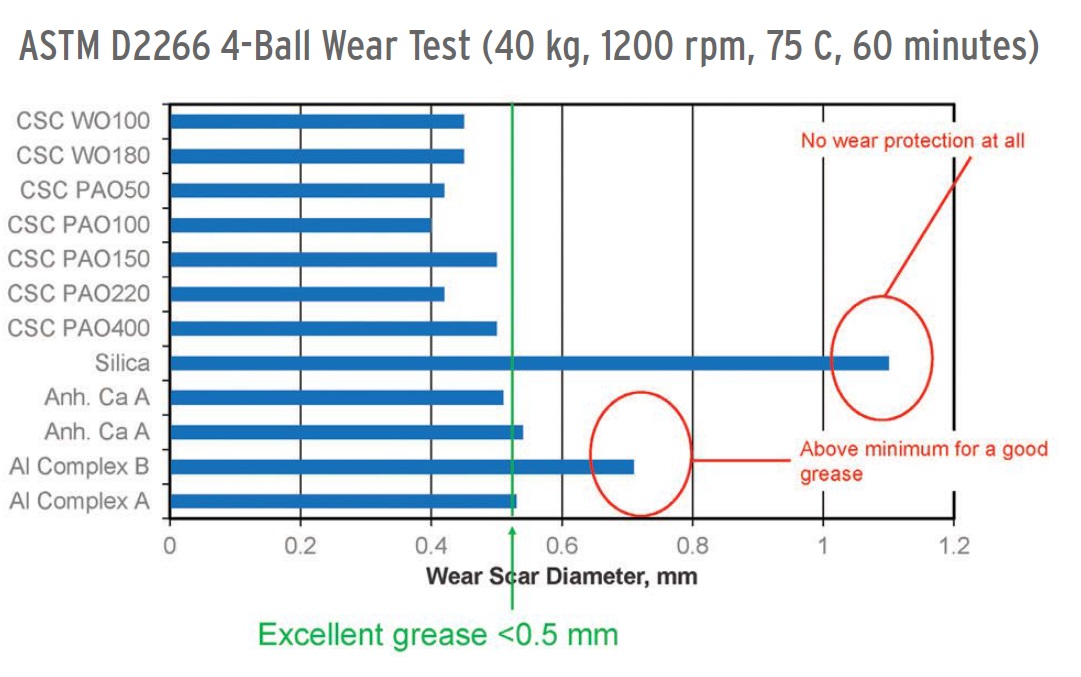 Figure 12. Comparing antiwear properties of food-grade CSC and non-CSC greases. (Figure courtesy of Chemtura Corp.)
Figure 12. Comparing antiwear properties of food-grade CSC and non-CSC greases. (Figure courtesy of Chemtura Corp.)
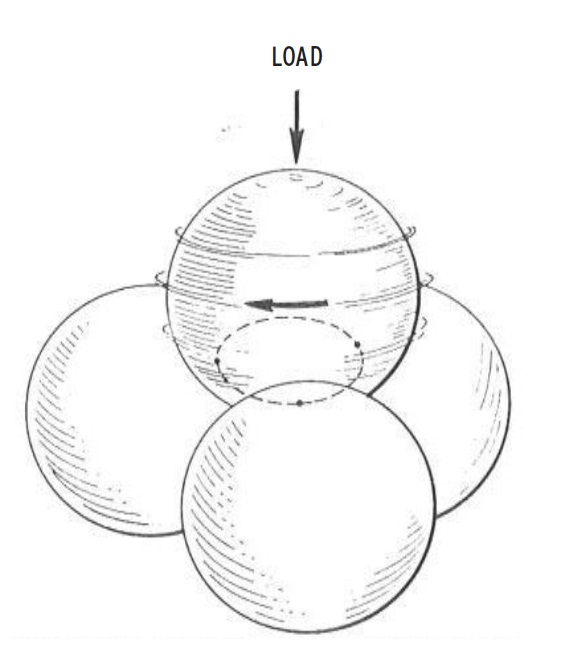 Figure 13. How grease load carrying properties are tested with the 4-Ball EP Test. (Figure courtesy of Chemtura Corp.)
Figure 13. How grease load carrying properties are tested with the 4-Ball EP Test. (Figure courtesy of Chemtura Corp.)
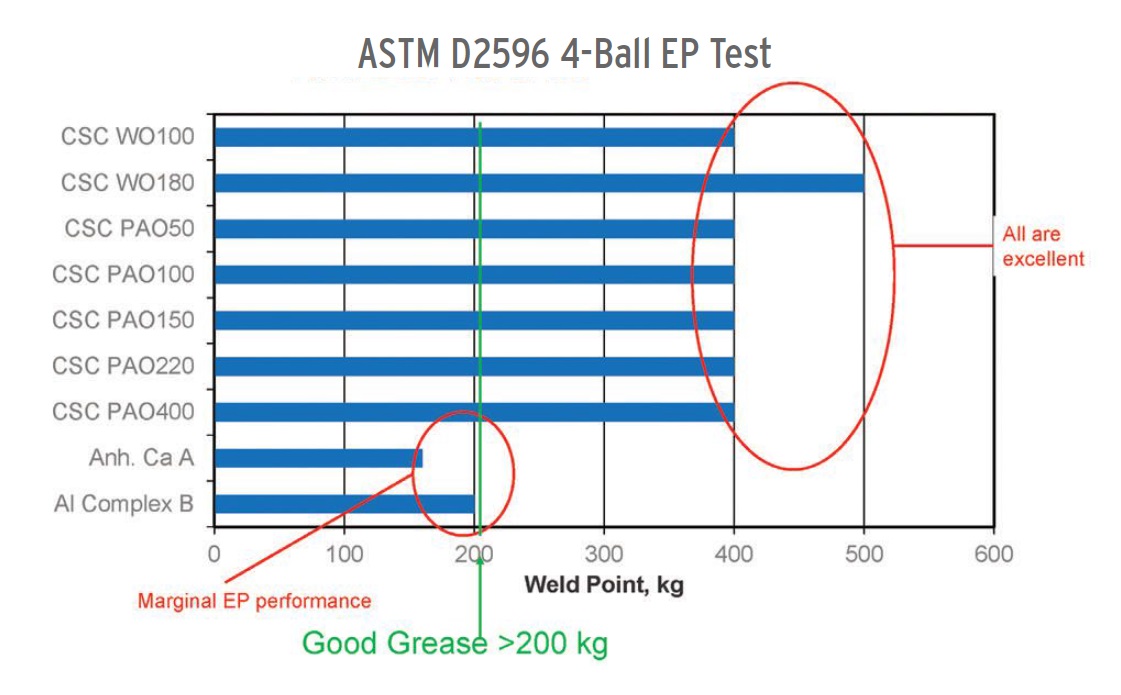 Figure 14. Comparing load carrying properties food-grade CSC and non-CSC greases. (Figure courtesy of Chemtura Corp.)
Figure 14. Comparing load carrying properties food-grade CSC and non-CSC greases. (Figure courtesy of Chemtura Corp.)
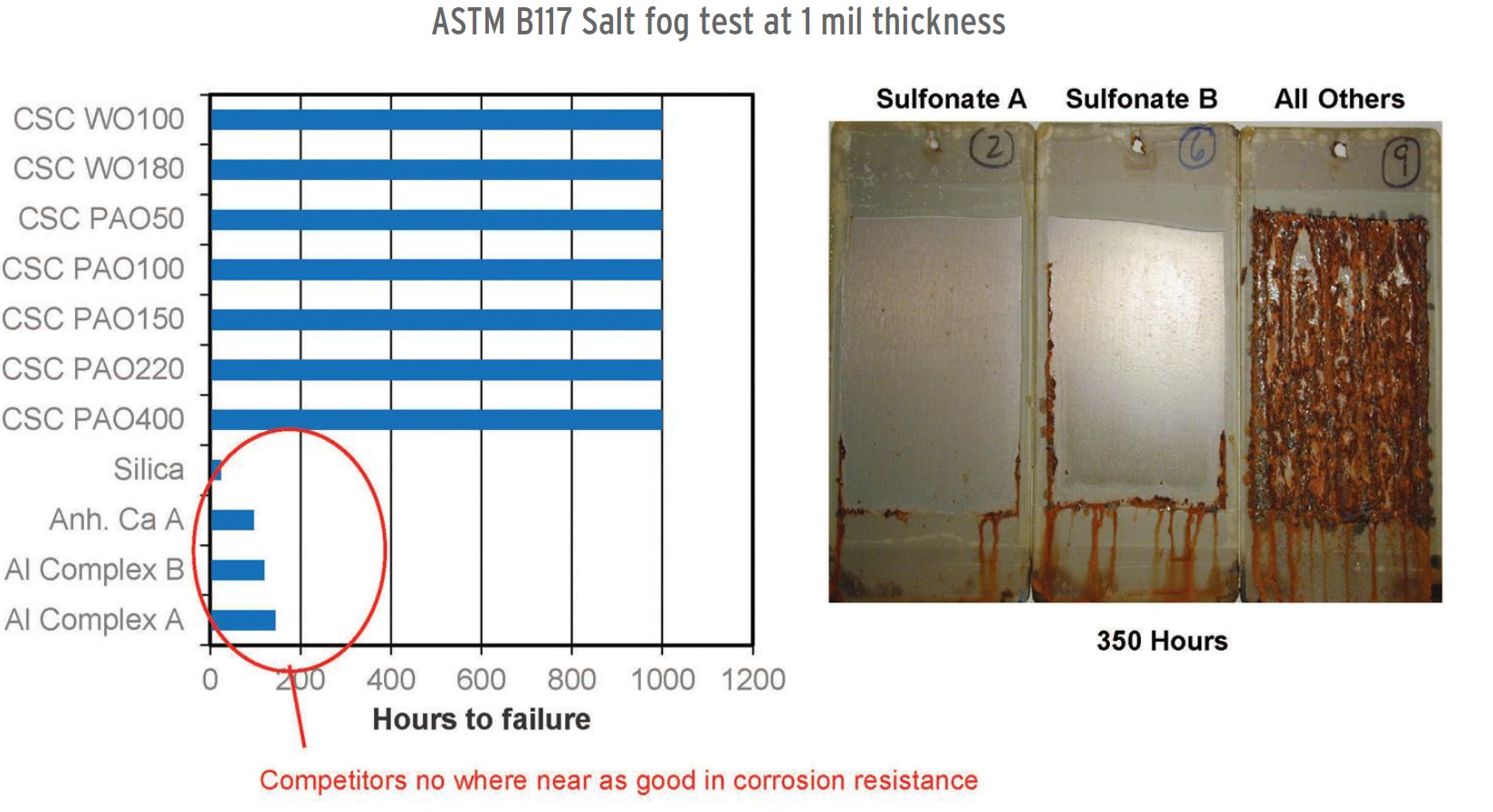 Figure 15. CSC grease offers superior corrosion resistance. (Figure courtesy of Chemtura Corp.)
Figure 15. CSC grease offers superior corrosion resistance. (Figure courtesy of Chemtura Corp.)
CSC greases are stable regardless of temperature during shear tests, while other thickener types softened with time and heat. With water added to roll stability tests, other products became much softer as their ability to gel was disrupted and the thickeners broke down, depending on the thickeners used, but CSC greases remain stable.
STEEL MILL EXAMPLE
Steel mills are the largest global consumer of grease. In China alone there is an estimated 100,000 metric tons or more of grease consumption in the steel industry. Grease in these applications are subject to high loads, high heat and water. Comparing ISO 460 CSC grease to several commercial products found in steel mills, the CSC grease did exceptionally well when operating temperatures were above 150 C, offering many performance advantages.
In a transportation roller bearing application in a hot rolling mill, very short bearing lifetimes were seen with its standard NGLI 2 lithium grease needing to be fed every eight hours. An ISO 460 CSC grease investigated for 7-10 days offered a significant improvement in performance and bearing life, and extended the re-greasing interval from eight to 24 hours.
In a similar steel mill bearing test, ISO 460 CSC grease tripled the bearing life from 10 to 30 days with the original grease to more than 45 days. It also extended the re-greasing interval to 72 hours.
In another steel environment using polyurea grease, shortened bearing lives were seen after the grease became thinner after contamination with water. That effect was not seen after switching to CSC grease.
OTHER INDUSTRIES
In addition to these examples, CSC greases bring performance advantages to a variety of industries. They bring excellent EP, wear, corrosion and wide-temperature advantages to wind turbines, open gear in mining applications, on pin bushings and in bearings. They also offer water resistance and mechanical stability to wet end bearings, good corrosion resistance to marine applications that use wire ropes and EP and wide temperature performance to marine deck equipment. They’re used in power generation and off-road construction industries and offer good heat, corrosion, EP, wear and radiation protection in motorized steam valve applications.
FOR MORE INFORMATION
Chemtura Corp.:
www.chemtura.com
Debbie Sniderman is an engineer and CEO of VI Ventures, LLC, an engineering consulting company. You can reach her at
info@vivllc.com.